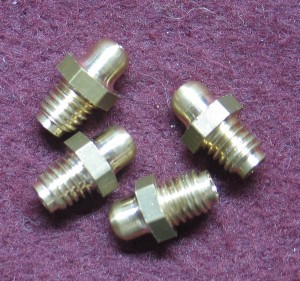
Grease nipples are manufactured for use where the article to be lubricated can not be broken down easily thus upsetting fixed running clearances or difficult to reach parts. I have had a look at some early i.e. 1920’s nipples from a KTT Vellocette that wanted exact replication. First the reader has to understand exactly how a grease nipple works and how it should be constructed. A grease nipple can be made from any metal or plastic. Generally they are made from steel or brass. When a grease gun is applied to the nipple the gun has to be pressurized by hand. Pushing down on the gun produces the required pressure to force grease into the nipple which is located very close to the part to be lubricated. The basic construction of a nipple is a body of metal cylindrical in form with a ball and a spring fitted in the bore. If one inspects an early nipple, let’s say 1920; one should see the spring loaded ball protruding from the nipple. The point of the ball in nipple construction is solely to act as a one way valve and keep grit out. Prior to attaching the grease gun one should wipe a finger over the top of the nipple to clear any possible grit. Modern nipples on the market now do not carry out there duties of keeping grit out during lubrication. This is because the spring loaded ball sits well below the surface of the nipple. The ball that sits below the nipple face dose not protrude the face at all and has a layer of grease above it. The problem with grease sitting or proceeding the spring loaded ball, is it’s a grit trap, wipe your finger over this construction and you will only introduce grit into the mechanism. My argument is why bother manufacturing something so poorly designed when we have computer numerical controlled machines that can produce products like these within few microns.

Hi,
My 1951 Peugeot motorcycle has the type of grease nipples you describe and ar similar in design to the ones your photo. Any idea what grease gun I should be using?
You are right by the way, the ball bearing does protrude and is easily wiped to reveal a shiny bearing even having not been lubed for at least 60 years.
Regards
Patrick.
I can’t say as to what type or where to get one, but some research on google should throw up some results.